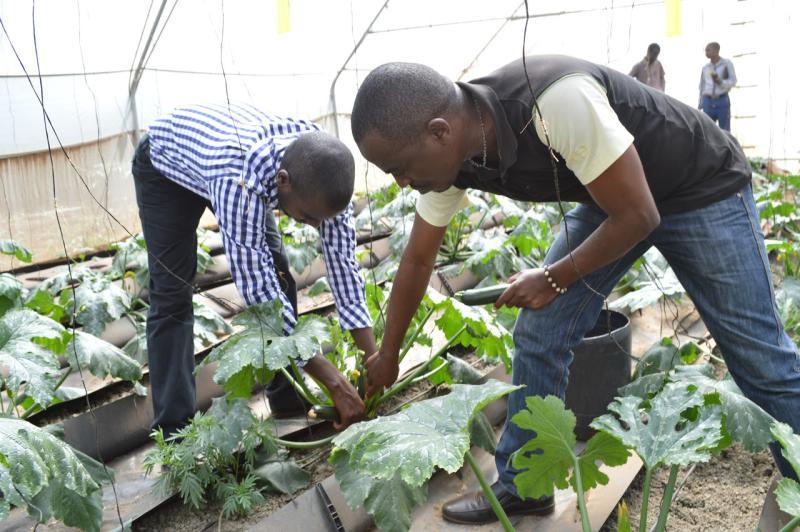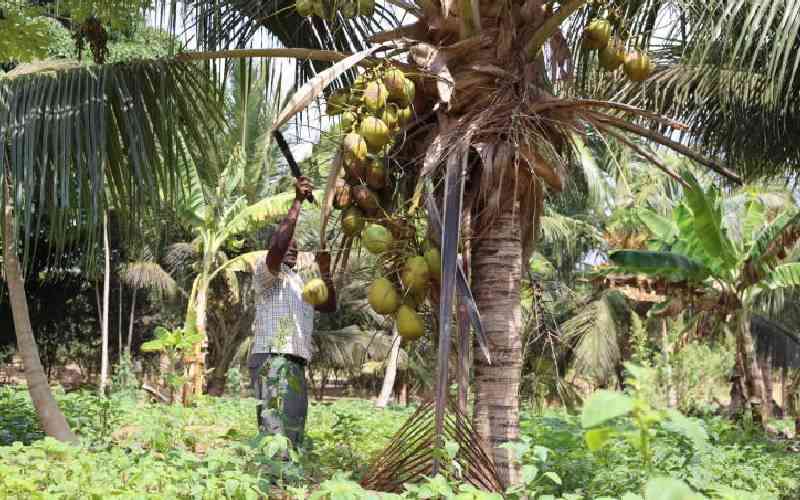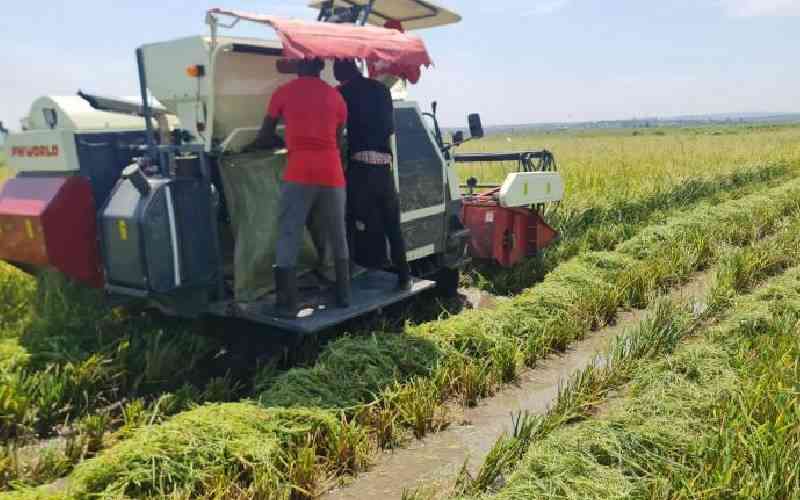
At Peninah Munyithya’s one-acre farm in Kasarani, off the busy Thika Highway, there are several small gardens of kales, spinach, tomatoes and herbs. There is also a chicken coop where the city dweller rears 300 kienyeji chicken for eggs and meat.
Munyithya is a full-time extension officer whose clients are mainly urban dwellers growing crops and rearing animals within and around the city.
Munyithya who has been farming for 10 years says the venture has provided her with an additional source of income. She chose to do integrated farming to ensure that she gets a steady flow of income.
“This area of the city is mostly dry and when we lack water for irrigation, I don’t make much from the crops. In such times, I make money from my chicken,” Munyithya says.
The chicken supply her with the manure she needs for organic farming to meet her customers’ demand for organic produce.
“City dwellers are becoming more concerned about what they eat and most of them prefer organic produce that is free of farm chemicals. I decided to do poultry alongside vegetable farming to have a steady supply of organic manure,” she says.
Munyithya isn’t the only one in the venture that is giving Nairobi and other cities around the world a new face.
Munyithya has given advice to hundreds of urban farmers doing hydroponics in their garages, on their balconies and in their green offices.
Nairobi and Environs Food Security, Agriculture and Livestock Forum (NEFSALF) estimates that at least 20 per cent of Nairobi residents amounting to around 200, 000 households are engaged in farming activities at different levels. Further, it is estimated that seven per cent of these farmers also keep livestock.
The NEFSALF report indicates that most of these farmers in Nairobi belong to middle-income households who have free spaces in their residences.
“They (middle-income households) have backyards and can farm more easily than the poor who live in crowded informal settlements and usually farm in open spaces. Poor people are constantly losing access to a place to grow crops or keep livestock, which means their right to adequate food and nutrition is under threat from competing land uses,” reads the report.
About 40 per cent of African urban households practice urban farming, mostly to supplement their diet and save on food expenses, according to the report. Urban farming practices such as indoor hydroponics have been acclaimed for production of crops that are free from pesticides and pollutants.
Compared to conventional farming, hydroponics can ensure a steady supply of produce all-year round in limited spaces.
It also allows for water recycling, minimising water requirements of crops. It’s only flaws are the high set-up investments, susceptibility to power outages and the fact that it requires constant supervision and monitoring.
Stay informed. Subscribe to our newsletter
Prof Stephen Dianga, the dean at School of Architecture dean at Jomo Kenyatta University of Agriculture and Technology (JKUAT) says land use is becoming increasingly competitive especially around cities, underscoring the need for urban farmers to become more innovative.
“The face of Nairobi city towards Kiambu has been changing in the recent years. The large tracts of land covered with coffee have since been converted into buildings,” says Prof Dianga.
The JKUAT professor says real estate is slowly taking over from farming in areas around cities, forcing city dwellers to farm on limited spaces.
Mr Jeremiah Mbugua, a JKUAT extension expert foresees a future where urban farmers will be forced to adopt space intensive and water saving technologies such as non-soil production technologies on roof tops.
Greenhouse for verandahs
“I have seen a farmer along Kiambu Road in Nairobi near the bypass who has large greenhouses on two residential houses. These are practices thriving in developed countries but which are slowly being adopted locally,” Mr Mbugua says.
At JKUAT, researchers have developed a small greenhouse that can fit in a backyard or on a verandah. The six-by-four greenhouse with a capacity to hold 60 tomato plants can feed a family of five for two months.
Other countries have more advanced urban farming technologies on residential vegetable gardens, vertical farming, rooftop farming as well as urban community gardens.
Others have incorporated Internet of Things in city farms to facilitate easy supervision and monitoring of the farms.
Vertical farms
Sarah Itambi who runs Smart Urban Farm Technologies, an organisation that offers training in urban farming technologies and designs farming equipment, says farmers are increasingly putting up vertical structures.
“I have been working with urban farmers for nine years now and I have seen a significant increase in farmers who request for vertical farming structures. Few people are still doing the horizontal farming on the ground,” Ms Itambi says.
In Malaysia, a startup CityFarm, one of the biggest urban farming companies in the world manufactures vertical farm modules with a capacity of more 1,000 crops, complete with artificial light for indoor installation.
The company sells agricultural grow lights that are customised according to different crop requirements.
CityFarm manages the 4,500-square-feet Swan CityFarm, an indoor plant factory with artificial lighting at Sarawak in Malaysia, an alarm indoor vertical farm and several green offices across the country.
Rooftop Farming
Prof Dianga says engineers plan for rooftop farming while designing the building. “Rooftop farming is common in developed countries where the last floor of the building is designed to hold soil, a greenhouse, an irrigation system and any other weight related to farming.
“In Kenyan residential places, the last floor of buildings is where tenants dry their laundry.”
USA-based startup Sky Vegetables develops and operates urban hydroponic rooftop farms based on recycled rainwater irrigation.
Sky operates an 8,000-square-feet rooftop farm situated on top of a building to distribute lettuce, bok choy, and herbs to many food chains.
The challenges
One of the challenges that urban farmers face is keeping various parameters on their farms.
Internet of Things sensors assist in mitigating this challenge by mining data about important farm factors such as soil, air, water, and climate for forecasting and analysis.
These smart farming systems automatically adjust farm equipment to the changing conditions and allows for remote control.
Many smart farming technologies are coming up to design sensors, software and other connected devices to measure humidity, air and water temperature, delivering this information to farmers on their smart phones and computers.
The JKUAT extension expert says farmers are already expressing interest on digital farming technologies.
“At the university, we have already trained farmers who expressed their interest in managing automated systems on their farms,” Mbugua says.
“Most of them are employed people who are eager to run fully automated gardens and chicken structures away from their workplaces.”
He adds: “They want to remotely switch on an irrigation system at the garden and to regulate heat in brooding spaces at a click of a button.”
 The Standard Group Plc is a
multi-media organization with investments in media platforms spanning newspaper
print operations, television, radio broadcasting, digital and online services. The
Standard Group is recognized as a leading multi-media house in Kenya with a key
influence in matters of national and international interest.
The Standard Group Plc is a
multi-media organization with investments in media platforms spanning newspaper
print operations, television, radio broadcasting, digital and online services. The
Standard Group is recognized as a leading multi-media house in Kenya with a key
influence in matters of national and international interest.
 The Standard Group Plc is a
multi-media organization with investments in media platforms spanning newspaper
print operations, television, radio broadcasting, digital and online services. The
Standard Group is recognized as a leading multi-media house in Kenya with a key
influence in matters of national and international interest.
The Standard Group Plc is a
multi-media organization with investments in media platforms spanning newspaper
print operations, television, radio broadcasting, digital and online services. The
Standard Group is recognized as a leading multi-media house in Kenya with a key
influence in matters of national and international interest.










